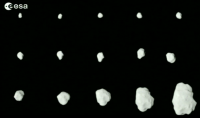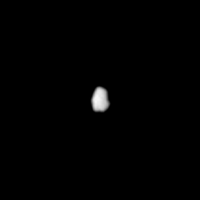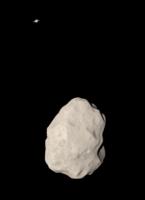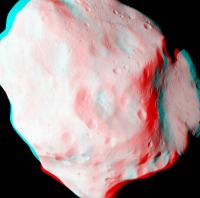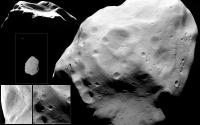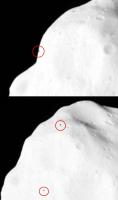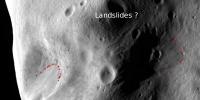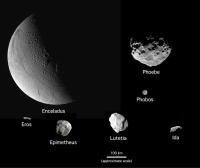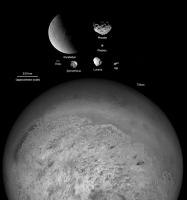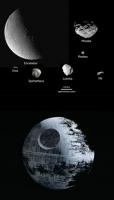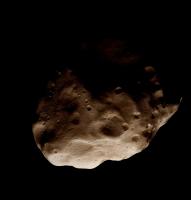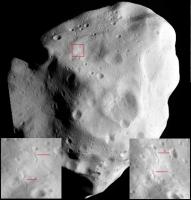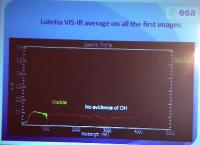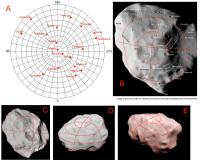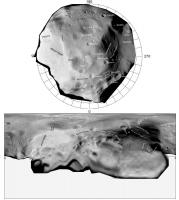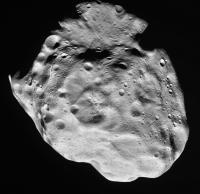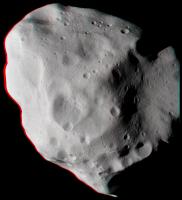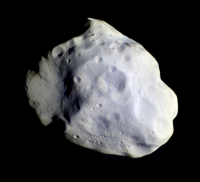Printable Version of Topic
Click here to view this topic in its original format
Unmanned Spaceflight.com _ Rosetta _ Rosetta flyby of Asteroid Lutetia
Posted by: Paolo Dec 26 2009, 07:35 PM
time to start a thread on one of the most interesting UMSF events of 2010...
Published thu on arXiv http://arxiv.org/abs/0912.4572
Posted by: Patteroast Dec 28 2009, 01:47 AM
Lutetia will be the largest asteroid visited by a spacecraft, at least until 2011. ![]() The current record is held by Mathilde, but Lutetia's twice as big. It'll be the first asteroid of spectral class M to be visited, although it doesn't appear to be metallic... it should be a fun one.
The current record is held by Mathilde, but Lutetia's twice as big. It'll be the first asteroid of spectral class M to be visited, although it doesn't appear to be metallic... it should be a fun one. ![]()
Posted by: Paolo Dec 28 2009, 09:48 AM
Actually the class of Lutetia is disputed, and it now seems more likely that it resembles some types of carbonaceous meteorites
these are some papers summarizing the results in support of the Rosetta flyby:
http://www.aanda.org/index.php?option=article&access=standard&Itemid=129&url=/articles/aa/abs/2008/02/aa8085-07/aa8085-07.html
http://www.aanda.org/index.php?option=article&access=standard&Itemid=129&url=/articles/aa/abs/2008/07/aa8053-07/aa8053-07.html
http://www.aanda.org/index.php?option=article&access=standard&Itemid=129&url=/articles/aa/abs/2009/16/aa10184-08/aa10184-08.html
Posted by: Paolo Dec 29 2009, 10:05 AM
A quick recap of facts about Lutetia from "Robotic Exploration of the Solar System - Part 3":
Posted by: Paolo Mar 10 2010, 06:12 AM
Two papers about Lutetia on arXiv today:
http://arxiv.org/abs/1003.1923
http://arxiv.org/abs/1003.1845
Posted by: stevesliva Mar 12 2010, 05:46 AM
I just saw a reference to papers by Busarev et al, that suggest Lutetia could be a binary. That would be neat. But alas, perhaps the concavity is more likely.
Posted by: Paolo Apr 17 2010, 10:03 AM
http://www.aanda.org/index.php?option=article&access=standard&Itemid=129&url=/articles/aa/abs/2010/05/aa14051-10/aa14051-10.html is now published (and free to access!) in Astronomy & Astrophysics
Posted by: Paolo May 1 2010, 08:38 AM
http://meetingorganizer.copernicus.org/EGU2010/EGU2010-11603.pdf: the Ptolemy mass spectrometer on the Rosetta orbiter will attempt to detect a faint exosphere around Lutetia
Posted by: Explorer1 May 1 2010, 08:44 AM
It would have to be faint indeed. If confirmed, that would be the smallest known body with an atmosphere, correct?
I can't think of anything off the top of my head smaller then Enceladus that has one....
Posted by: nprev May 1 2010, 09:06 AM
"Exosphere" in this context seems like a pretty broad application of the term, though. Any solid body is going to emit a certain amount of gas in a vacuum, however exceedingly small that might be.
It's a smart & interesting experiment nevertheless. There appears to be a continuum of possible volatile content levels for members of the Belt's general asteroid population as well as an increasing number of objects that seem to be intermediate between the traditional categories of "comet" & "asteroid". Measuring the emissions of Luetia will provide some very valuable baseline data that directly pertains to all that.
Posted by: Explorer1 May 1 2010, 09:38 AM
I think a good rule of thumb would be: it's an atmosphere if the body it surrounds is more or less spherical. That's a good a reference point as any right? Lutetia is excluded, but Ceres and maybe Vesta wouldn't be.
I doubt Hyperion or Proteus will break that rule anytime soon...
Posted by: lyford May 1 2010, 06:03 PM
This discussion seems to becoming perilously evocative of another debate. I hope we don't have to create a new class of "dwarf atmospheres" ![]()
![]()
Posted by: nprev May 1 2010, 07:36 PM
Somebody please correct me if I'm wrong, but wouldn't a gravitationally-bound gaseous envelope (yep, intentionally avoiding the "A" word, here) be spherically distributed around a body's center of mass regardless of its gross shape? In fact, wouldn't it follow the contours of its Hill sphere?
There might be pronounced local variations if there were very significant asymmetries in a body's internal mass distribution, but they'd have to be really big mascons, almost certainly much, much larger than any you'd expect to find on an asteroid.
Posted by: Hungry4info May 1 2010, 10:47 PM
I think you're right, nprev. We don't see the atmospheric pressure at the top of Mt Everest being any higher than at any other equal altitude on Earth (though this may be a bad example due to the high mass of the planet).
Also, just to throw this in, Mercury has a non-spherical exosphere due to stellar wind effects.
Posted by: JGodbaz May 2 2010, 10:32 AM
The air pressure tends to be substantially lower at the poles, even at the same altitude. For example, the summit of Denali (at about 6.2 km) has an air pressure equivalent to that at 6.9km altitude in the Himalayas (say Everest).
Posted by: Hungry4info May 2 2010, 12:15 PM
Could that be explained by both Earth's rotation and the polar temperature?
Posted by: Paolo May 24 2010, 07:24 AM
Lutetia flyby navigation to start end of May http://sci.esa.int/science-e/www/object/index.cfm?fobjectid=47040
Note also that Rosetta's instruments have been used to collect a lightcurve of Vesta recently
Posted by: Explorer1 May 24 2010, 07:57 AM
Incidentally, is there a particular method for pronouncing Lutetia? Is it phonetic or what? It's bothered me for a while and I'd like to clear it up before Rosetta gets any closer. ![]()
Posted by: volcanopele May 24 2010, 08:06 AM
I've been going with LOOT-eh-shee-ah. Not sure if it is right, though.
Posted by: Paolo May 24 2010, 08:12 AM
should be approximately loot-eh-see-ah
Posted by: ElkGroveDan May 24 2010, 02:06 PM
I think Paolo's version is closer, but I've also heard it said as loo-TET'-see-ah
Posted by: Stu May 24 2010, 02:58 PM
I'd have thought "Loo-TAY-shee-ah" myself...
Posted by: ugordan May 24 2010, 03:59 PM
Loo-TEE-shee-ah?
Posted by: Bart May 24 2010, 06:25 PM
Well, since it is the Latin name for Paris, I would defer to our French members.
Posted by: nprev May 24 2010, 06:50 PM
Okay, I'll play: "Loo-TEE-sha". ![]()
Posted by: jekbradbury May 24 2010, 06:58 PM
The Wikipedia article says it's /ljuːˈtiːʃiə/ (lew-TEE-shee-uh) but also says it's possible to pronounce it as Latin (Lutētia), that is, loo-TAY-tee-ah.
Posted by: nprev May 24 2010, 07:13 PM
Beginning to appreciate the IAU's asteroid numbering system more & more...I know how to say "21". ![]()
Posted by: Paolo May 31 2010, 03:02 PM
There are two very interesting papers on adaptive optics observations of Lutetia on arXiv today:
http://arxiv.org/abs/1005.5356
http://arxiv.org/abs/1005.5353
turns out Lutetia spins on its side like Uranus, and one entire hemisphere will not be illuminated when Rosetta swings by. As for the shape,
Posted by: charborob Jun 17 2010, 04:17 PM
Rosetta has started imaging Lutetia. Not much to see yet. The images are used for navigation purposes.
http://webservices.esa.int/blog/post/5/1191
Posted by: tasp Jun 17 2010, 08:51 PM
Can't see the moons or rings or volcanoes yet . . . .
Reassuring the craft is on target and the trajectory tweaks are being computed. Getting pretty excited to see this rock up close.
Posted by: dilo Jun 18 2010, 06:28 AM
http://arxiv.org/abs/1005.5356
...
From first article I made this rough animation of the rotating asteroid (time intervals aren't proportional):
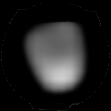
North is up/above image plane
EDIT: I removed second frame in order to have more fluid/consistent rotation
Posted by: cassioli Jun 24 2010, 11:28 AM
I'm from Italy and I studied LAtin at school.
I think "LOOT-eh-shee-ah" is wrong due to the "H" in "shee".
I think the best aproximation in your proposals is "loo-TET'-see-ah ", as the second T must be read as a Z; I mean, "Lutetia" would be "Lutezia" in Italian. Unfortunately looks like you have no "Z" sound in English, so you need to "aproximate" it by "ts", just as you like when saying "grazie" (="thanks").
Posted by: vikingmars Jun 24 2010, 01:08 PM
[quote Unfortunately looks like you have no "Z" sound in English... [/quote]
Yes, we have ! ![]()

Posted by: Mongo Jun 24 2010, 03:32 PM
Both German and Italian use the letter Z to represent the "ts" sound. Strange that both languages' orthographic systems have this feature, since German and Italian are not that closely related within the Indoeuropean language family. Perhaps their time joined together under the Holy Roman Empire was one reason for this shared orthographic feature.
Posted by: cassioli Jun 25 2010, 07:08 AM
"Romans. Romans everywhere".
Posted by: Hungry4info Jul 7 2010, 03:14 PM
Rosetta Right on Target for Lutetia flyby
http://webservices.esa.int/blog/post/5/1223
Gentle reminder that it's in 3 more days...
Posted by: alan Jul 8 2010, 05:53 AM
Love this quote from the Planetary Society blog
Posted by: dmuller Jul 8 2010, 06:45 AM
The ESA operations center ESOC is in Darmstadt, Germany, and Germany is in that game against Uruguay. So I guess they want to avoid publishing that "spherical leather-like surface with hexagonally shaped canyons" as the surface of Lutetia.
![]()
Posted by: cassioli Jul 8 2010, 06:50 AM
any new image of the approaching?!? ![]()
which "on ground" resolution will the onboard camera be able to reach?
Posted by: charborob Jul 8 2010, 01:46 PM
If I didn't make mistakes in my calculations, resolution should be around 60m/pixel.
Posted by: elakdawalla Jul 8 2010, 02:23 PM
They won't actually resolve Lutetia as an object with a shape until hours before closest approach, so while they could technically be posting more approach photos, they wouldn't really look any different from the ones already posted.
Posted by: Enceladus75 Jul 8 2010, 02:45 PM
Looking forward to this flyby as it will add yet another asteroid to the list of objects visited by a spacecraft and studied up close. ![]() Will Rosetta be taking other measurements of Lutetia apart from images?
Will Rosetta be taking other measurements of Lutetia apart from images?
Posted by: elakdawalla Jul 8 2010, 03:00 PM
Enceladus75, the answer to your question was posted earlier today on http://webservices.esa.int/blog/blog/5
Posted by: Enceladus75 Jul 8 2010, 03:18 PM
Thanks a million Emily.
Posted by: Alan Stern Jul 9 2010, 12:54 PM
Yes, IR mapping spectroscopy, thermal mapping, UV coma searches, UV reflectance spectroscopy, magnetic field search, the list goes on...
Posted by: Phil Stooke Jul 9 2010, 05:31 PM
http://webservices.esa.int/blog/post/5/1231
Getting bigger!
Phil
Posted by: dmuller Jul 9 2010, 05:42 PM
I have (at last!) added the "angular diameter" and other calculations to my realtime simulation at http://www.dmuller.net/rosetta
Posted by: belleraphon1 Jul 9 2010, 07:21 PM
Another worldlet coming into our view... love it!
Craig
Posted by: maschnitz Jul 9 2010, 10:45 PM
(Aside: hey, dmuller - ESA linked to you - http://webservices.esa.int/blog/post/5/1232 ![]() )
)
Posted by: Hungry4info Jul 10 2010, 06:02 AM
According to the Rosetta Real-Time Simulation, they've started the flip manouevre.
Posted by: dmuller Jul 10 2010, 07:06 AM
Not yet ... the red box is the "next event" ... start of the flip maneuver is still some 4 hours away.
EDIT: Will try to make it clearer in version 3 of the sim
Posted by: Hungry4info Jul 10 2010, 10:37 AM
Ahh okay. My mistake.
From the Rosetta Blog.
Less than 330,000 km!
http://webservices.esa.int/blog/post/5/1238
Posted by: cassioli Jul 10 2010, 12:58 PM
160.000 km and counting!
http://www.dmuller.net/ is a REALLY cool site!
Will flyby image be live, or will they be released only after "18:19:53 Resume radio communications via high-gain antenna - Acquisition of TM signal (latest)" ? ![]()
Posted by: Hungry4info Jul 10 2010, 01:58 PM
I'm guessing after they re-establish contact with Rosetta.
Maybe at
"16:00:00 Resume Webcast - Media Event Life from ESA/ESOC - Science Team Present Images"
Posted by: elakdawalla Jul 10 2010, 02:17 PM
The first images will not be released until just after the World Cup Match is over; the schedule says 23:05 CEST but it could be later if the match runs into overtime.
Daniel: Your simulation is, as usual, terrific, but there's one thing about it that's a bit confusing -- all spacecraft events are reported as SCET but the Earth events are reported in Earth time. Since one way light time is 25 minutes there's a significant difference. So your countdown has the webcast starting after closest approach, when in fact it starts before closest approach ERT....not sure what to recommend as a fix though, because I like events being reported as SCET but it wouldn't make sense to convert Earth events to SCET.
Posted by: dmuller Jul 10 2010, 02:46 PM
Emily: You've described my problem quite well! The ultimate solution will be to offer two realtime simulations, one in SCET, the other in ERT. The problem is the data processing, in particular converting events from SCET into ERT without blowing up the database (or doing everything manually!) My target to have that sorted out is the MESSENGER Mercury Orbit Insertion. Unfortunately there is no quick fix, other than leaving out Earth-based events (which I usually do), however, in this case I wanted to draw attention that ESA has a webcast.
maschnitz: it's great that people find the website useful. The link from ESA has certainly yielded many referrals. On 10 July (my local time in Australia), I had 2,200 visits (usually between 40 to 100).
Posted by: elakdawalla Jul 10 2010, 02:49 PM
Perhaps as a short term solution, for the few events you report that are on Earth (like the webcast) , you could just include text indicating what OWLT is and how to correct...
Posted by: dmuller Jul 10 2010, 02:55 PM
Sounds like a feasible idea. Too late to implement for Rosetta @ Lutetia, traffic to the site is too high at the moment and I won't risk messing up the database now
Posted by: Hungry4info Jul 10 2010, 03:34 PM
A webcast has started.
http://webservices.esa.int/blog/post/5/1244
"Rosetta is a spacecraft. Lutetia is an asteroid. Rosetta will fly by Lutetia." kind of stuff.
Posted by: volcanopele Jul 10 2010, 03:35 PM
LOL, of course the images will be presented only after I board my flight in Dallas...
Posted by: Hungry4info Jul 10 2010, 03:54 PM
Well, we passed closest approach a few minutes ago.
Edit: And here comes the live webcast.
Posted by: Phil Stooke Jul 10 2010, 04:21 PM
http://webservices.esa.int/blog/post/5/1246
Pics!
Phil
Posted by: Alan Stern Jul 10 2010, 04:38 PM
Alice UVS is doing the same.
Posted by: alan Jul 10 2010, 04:48 PM
Contact reestablished following close approach
Posted by: kenny Jul 10 2010, 05:02 PM
Wonderful images! 100 km across and no evidence of gravitional rounding. Any thoughts / evidence on what size that effect kicks in?
Congratulations to ESA.
Posted by: cassioli Jul 10 2010, 05:03 PM
fly-by mission accomplished. ![]()
heading to the comet now. ![]()
Posted by: Phil Stooke Jul 10 2010, 05:07 PM
"100 km across and no evidence of gravitional rounding. Any thoughts / evidence on what size that effect kicks in?"
That depends on the internal strength of the object, including its temperature history. Vesta at 500 km across is noticeably irregular - but rocky - whereas icy Mimas is only 400 km across and a bit elongated by tidal effects but a nice ellipsoidal shape.
Phil
Posted by: Loiserl Jul 10 2010, 05:08 PM
I just put the Lutetia close-up animation. I'll add more info for the Spanish speakers too: http://www.espaciosur.com.ar/2010/07/imagenes-del-encuentro-con-rosetta.html - Cheers.
Posted by: dilo Jul 10 2010, 05:27 PM
Loiserl, you beat me. In my version, I introduced dissolvence between most recent frames because the time lapse is clearly larger...
Posted by: Stu Jul 10 2010, 05:37 PM
Very easily done, and it really doesn't matter, does it?
Posted by: Phil Stooke Jul 10 2010, 06:10 PM
Playing around with contrast a bit and rearranging the images in the big composite...
One frame was flipped (mirror-image) left-right - the top one in the left column in this version.
The second image in the sequence (one up from lower left corner) is approximately the same view as the last image, so these cover a full rotation. They are approximately north-up here. Images of course are courtesy ESA and the Rosetta and OSIRIS teams, and a big thanks to them for releasing them so soon.
Phil
Posted by: dilo Jul 10 2010, 07:23 PM
Thank you Phil for your analysis... I used last two frames (with some relative rotation) in order to create following stereograms:
crossed eyes:
parallel eyes:
Some artifacts/incongruences are due to slightly different illumination, I guess!
Posted by: alan Jul 10 2010, 09:03 PM
Live webcast is started
Posted by: ugordan Jul 10 2010, 09:04 PM
http://webservices.esa.int/blog/post/5/1247
Lutetia and Saturn!!! http://webservices.esa.int/blog/gallery/5/2_Lutetia_and_Saturn.png
Posted by: alan Jul 10 2010, 09:07 PM
Reminds me of Phobos
http://webservices.esa.int/blog/gallery/5/6_Lutetia_OSIRIS_LAM_2.jpg
Posted by: Phil Stooke Jul 10 2010, 09:15 PM
The best set of grooves on any object since Phobos. This has to put an end to the 'grooves caused by Mars ejecta' argument. fantastic object and a wonderful data set. And this is just the highest priority data, all the rest still to come.
Phil
Posted by: cassioli Jul 10 2010, 09:21 PM
Never seen before: an asteroid with a planet in its background... and it's not ITS "own" planet!
Posted by: nprev Jul 10 2010, 09:38 PM
Very first thing I thought when seeing these as well, Phil.
The image with Saturn in the distance...
Posted by: nprev Jul 10 2010, 09:44 PM
Sweet, Gordan! ![]()
So far, gotta say that Rosetta would be a frontrunner choice if I was allowed to ride along with a spacecraft (remember the Mars flyby pic?)
Posted by: ugordan Jul 10 2010, 10:06 PM
Some parts of that terrain look so smooth, it reminds me of one MRO image where the surface imaged is so smooth you get the effect the camera is out of focus (and only a crater here and there broke that illusion).
Posted by: ElkGroveDan Jul 10 2010, 10:11 PM
WOW OH WOW OH WOW!
Someone tell me there's at least a three filter set of this image.
Posted by: peter59 Jul 10 2010, 10:11 PM
Strange, It looks like shadows. The first is clearly elongated. Optical errors or real shadows ?
Posted by: ugordan Jul 10 2010, 10:14 PM
Crud in in the optics, I'd say.
Posted by: ElkGroveDan Jul 10 2010, 10:15 PM
Totally agree. It has a very "Phobosian" look about it. If I may coin a phrase.
Posted by: machi Jul 10 2010, 10:24 PM
Fantastic flyby! Evidently NAC camera worked flawlessly.
Some smooth areas - possible landslides ?
Posted by: ngunn Jul 10 2010, 10:28 PM
Don't worry. If there wasn't Gordan will provide one.
I'm kicking myself now because when I looked at the last few approach shots I thought I saw linear features that might be Phobos-like grooves (at the bottom of the images) but didn't have the courage to post.
Posted by: NickF Jul 10 2010, 11:13 PM
Here's a quick composite showing Lutetia very approximately to scale with some other icy and rocky bodies from the Solar System.
Posted by: nprev Jul 10 2010, 11:17 PM
Nice, Nick! That's an excellent scale reference.
Posted by: Alan Stern Jul 10 2010, 11:41 PM
I'd love to see Triton on there for scale!
Posted by: alan Jul 10 2010, 11:55 PM
Above the smooth areas in the left crater the surface looks either wrinkled or layered.
Posted by: NickF Jul 11 2010, 12:31 AM
Happy to oblige
Posted by: Alan Stern Jul 11 2010, 12:53 AM
Thanks Nick- That shows just what I wanted!
Alan
Posted by: Phil Stooke Jul 11 2010, 01:53 AM
Triton? Are you sure you don't mean Pluto?
Phil
Posted by: DrShank Jul 11 2010, 02:21 AM
Some smooth areas - possible landslides ?
looks that way. my guess would be that it is material displaced laterally when the small crater on the rim just above it hit.
a landslide true but one with a violent origin!
Posted by: Alan Stern Jul 11 2010, 02:56 AM
Phil
;-)
Posted by: dilo Jul 11 2010, 06:11 AM
Continuing kidding, Death Star 1 should appear comparable to Lutetia, indeed (120 km is the "official" diameter)...
Posted by: Stu Jul 11 2010, 10:33 AM
(taken from: http://cumbriansky.wordpress.com/2010/07/11/behold-lutetia )
Posted by: Drkskywxlt Jul 11 2010, 11:05 AM
Is that true color, Stu?
Posted by: Stu Jul 11 2010, 11:30 AM
Absolutely, catergorically, 1000000% not ![]()
As I say in the blog post, that's just me being all arty and creative with one of the images, making it more of a "fanciful portrait" than a true colour representation. Just a "pretty picture", and nowt wrong with that. ![]()
Posted by: Hungry4info Jul 11 2010, 11:30 AM
I don't believe it is. IIRC, Lutetia is expected to be mostly just black-and-white.
Posted by: Stu Jul 11 2010, 11:42 AM
I just said that.
The posts are both marked 12:30, so your post was probably posted while Hungry was typing.
Posted by: Hungry4info Jul 11 2010, 11:48 AM
Haha yep ![]()
Posted by: Phil Stooke Jul 11 2010, 01:18 PM
A composite of the last two approach images, the 'Saturn' image and the first of the high resolution set (thank you ESA and the OSIRIS team!)
It reveals an interesting fact... the last (top) image can only be made to match the others if it is flipped left to right - NOT a 180 rotation but a flip. One sequence or the other is reversed. I don't know which. I have these arranged north-up, assuming the approach images are not flipped. If they were flipped these are all south-up. The landslide crater is visible as a bright patch in the last few approach images and the Saturn image.
Phil
Posted by: ugordan Jul 11 2010, 01:55 PM
I don't understand why they don't take care of this automatically in their calibration pipeline. It's not the first time this happened, either - recall the Earth flyby image with Australia mirrored left-right.
Posted by: cotopaxi Jul 11 2010, 02:41 PM
I admit this is kind of a lame excuse, but the reason is most likely that the spacecraft was flipped 4 hours before closest approach (between the relevant images if I understand Phil correctly) and some of the early release images are taken from early processing levels. Normally those are then rotated and flipped "manually". Apparently we forgot that here......
Posted by: ElkGroveDan Jul 11 2010, 02:43 PM
Not just impacts, but massive impacts creating craters a significant portion of the diameter(s) of the objects. In both cases, the largest impacts probably approach the threshold for completely breaking up their respective bodies. It would make sense to suppose the massive impacts are somehow related to the grooves.
It's a matter of perspective. Because Phobos is so much smaller, you have to get a lot closer relatively to see the grooves. It's why the hairs on a flea seem more defined than the hairs on a rabbit.
Posted by: helvick Jul 11 2010, 04:05 PM
Lutetia's grooves certainly make it more likely that such features have an origin that does not rely on interactions with a planet, either from ring impacts or debris from large impacts on the surface of the planet. That's not to say they rule it out completely but I'm a lot less convinced about them now that we have evidence of very similar features on a body that almost certainly has never been near a planet. Shock effects from impacts, or (far less likely I think) tidal effects from passing near other bodies, seems much more likely now. The similarity with Phobos is quite spooky too.
I'm sure there will be many other interesting findings from this flyby but it's fantastic to see data come back immediately that should help develop better ideas about a really intriguing structural feature on small bodies that seems to be common and not understood.
Posted by: Stu Jul 11 2010, 09:18 PM
http://webservices.esa.int/blog/post/5/1248
![]()
Posted by: kenny Jul 11 2010, 09:41 PM
Very nice indeed... poetically rhythmic in measured time, even with the absence of normal rhyme.
Posted by: Hungry4info Jul 13 2010, 01:13 PM
I found a couple craters that seemed a bit strange. They have what look like crevaces jutting out of them.
These are the only two craters I've identified with this feature. Anyone have any idea as to what caused this?
Posted by: Phil Stooke Jul 13 2010, 01:16 PM
Emily mentioned these squiggly features in her blog. I think they are secondary craters from a fresh impact outside the image. Yes, I think you can have secondaries on Lutetia.
Phil
Posted by: cassioli Jul 14 2010, 10:01 AM
These are the only two craters I've identified with this feature. Anyone have any idea as to what caused this?
I noticed them at a first glance.
Just rolling stones, I suppose. Not FROM but TOWARD the craters.
Posted by: AndyG Jul 14 2010, 11:23 AM
Naturally these secondaries would have to have impact velocities less than Lutetia's escape velocity of ~80 m/s.
That's very low. Most (?) rocky impactors would survive the event. If any were visible in a crater for a mass estimate, then it might be possible to come to some estimates with regards to the surface's strength and structure.
Job for Dawn at Ceres and Vesta?
Andy
Posted by: tanjent Jul 14 2010, 03:41 PM
"Just rolling stones, I suppose. Not FROM but TOWARD the craters."
I like this idea, but then where are the stones? If they had rolled away again, they should've left tracks in that direction too.
Posted by: cassioli Jul 16 2010, 11:00 AM
no new images yet? ![]()
I like this idea, but then where are the stones?
nice question.
buried?
Some grooves are perpendicular to others...
Posted by: elakdawalla Jul 16 2010, 05:23 PM
I heard from the ESA Ops guys on Monday that the OSIRIS team isn't planning on releasing any more images.
Posted by: charborob Jul 16 2010, 05:34 PM
That's unfortunate, and seems to contradict what is said on the ESA Rosetta website: "All images received so far from OSIRIS team are now available in the ESA website. More updates to follow in the coming days."
I suppose they will eventually release all the images? Will they wait until scientific papers based on the data are published?
Posted by: djellison Jul 16 2010, 05:39 PM
Entirely unsurprising, but still disappointing.
Given that they've not dumped any of the data taken since launch to the PSA, those holding their breath for more imagery will probably have to do so for quite a few years.
Posted by: elakdawalla Jul 16 2010, 05:46 PM
Is there a data archive plan for Rosetta on the Web somewhere? I suspect that it says they don't have to submit data for archiving until some period of time after Churyumov-Gerasimenko arrival, but I don't know for sure.
Posted by: ugordan Jul 16 2010, 06:03 PM
There was one at the PSA I think, but as it turns out it's a sad joke - was 2008 for some OSIRIS data IIRC. I rarely even bother checking anymore.
Part of me thinks it'll be similar to the 1st Cassini PDS release, but what does really prevent DLR from sitting on the old OSIRIS data even longer?
Posted by: djellison Jul 16 2010, 06:03 PM
I've never found one. Alice has delivered very up to date data - as has MIRO and IES
http://pdssbn.astro.umd.edu/missions/rosetta/index.html
Posted by: elakdawalla Jul 16 2010, 07:22 PM
It might be worth it for some European person to send a polite email inquiry to Gerhard Schwehm and/or Rita Schultz asking about plans for public data release.
Posted by: cassioli Jul 18 2010, 12:22 PM
Given that they've not dumped any of the data taken since launch to the PSA, those holding their breath for more imagery will probably have to do so for quite a few years.
...as usual.
I really think ESA just posted those few "live" images to make us happy for the moment, and that's all. Just like for Steins, the're not going to release any more pictures: ESA is very jelaous of its own scientific data.
Posted by: Stu Jul 18 2010, 12:48 PM
I would have thought that once, too, but not any more. There are still serious problems with ESA's data release, and individual scientists do seem to want to horde their data and images like Smaug sitting on top of his pile of jewels and gold, but I really do think there's been a change within ESA re the importance of public outreach and making missions, and their image data at least, more accessible. The Lutetia images were released very quickly compared to previous missions; ESA is now blogging, and Twittering, like crazy, really informally and entertainingly in some cases, which is a phase change from years gone by.
This is VERY frustrating, I agree - and not just for us armchair explorers; I know through personal contact and correspondence with them, that there ARE people within ESA who absolutely get how vital it is for ESA to share its images and data more openly, and who really want to follow NASA's examples, and ESA's media people are much more on the ball now. But, as has been pointed out before, the trouble lies with the Beakers whose instruments collect the data. It appears that they're either unaware of the thirst for images and data "out here" beyond the confines of their labs, or they're aware but simply don't give a ****. If that's the case, we'll have to unwrap their clenched, skeletal fingers from around their images and data to get at them.
Posted by: dmuller Jul 18 2010, 05:35 PM
This may, or may not, be anecdotal evidence on the interest Rosetta @ Lutetia generated. The ESA blog linked to my realtime simulation site, and that generated heaps (for me, at least) of traffic which I can analyse: 4,500 visits from 2,200 visitors during the 48 hours around C/A. The geographic distribution:
1. United States 1,033
2. Japan 799
3. United Kingdom 515
4. France 380
5. Germany 255
Then in declining number of visits:
Australia - Canada - Czech Republic - Belgium - Italy - Netherlands - Sweden
And a whole set of other European nations, New Zealand and Colombia in the top 25
Posted by: cassioli Jul 19 2010, 08:33 AM
Could it be a matter of money?!? Do they release data only upon payment, to cover expenses for missions?!?
Posted by: Stu Jul 19 2010, 09:00 AM
Money might be a part of it, but at the end of the day I guess it all comes down to the scientists involved actually WANTING to release their images to the public because, like their NASA counterparts, they "get" that it's the right thing to do. Why? Because, contrary to what they might believe - or want to believe - the "little people" outside the scientists' shiny little Big Bang Theory labs are actually interested in what's "Out there" and would love to feel involved in the missions, if only by being able to see, and comment on, the pictures taken. Trust me: some people - a growing number of people, I think - within ESA DO "get it"... but the data horders have barricaded themselves in.
But this is getting a bit "woe is me", and threatening to overshadow the great achievement of this encounter. We should just celebrate the images we have for now ![]()
Posted by: ElkGroveDan Jul 22 2010, 05:29 PM
Discussion of groove formation has been moved to its own topic.
http://www.unmannedspaceflight.com/index.php?showtopic=6683&st=0
Posted by: Mariner9 Jul 23 2010, 01:30 AM
This question might have been brought up before, sorry if I missed it. I'm wondering how the instrumentation package on Rosetta compares to other asteroid encounters we have had in the last 20 years. Clearly the NEAR flyby of Mathilda was very limited (I seem to recall that only the camera was powered up), and I don't think we got much from flying past Anne Frank at such a long distance. But what about the Galileo flybys of Gaspra and Ida?
What I'm wondering is, will the final dataset on Lutetia be comparable to Gaspra and Ida, or is this more like comparing a Mariner 4 flyby of Mars to a Voyager flyby of Jupiter?
Posted by: machi Jul 23 2010, 06:09 AM
I think, that this question wasn´t here (but I´m not sure).
Some informations about operating instruments are in this status report
http://sci.esa.int/science-e/www/object/index.cfm?fobjectid=47448
On Philae Lander three instruments were operating - ROMAP (Rosetta Lander Magnetometer and Plasma Monitor) and two gas analysers (MODULUS PTOLEMY, COSAC).
Posted by: cassioli Jul 23 2010, 04:17 PM
can you image ESA using same policy on its images? ![]()
http://www.jpl.nasa.gov/news/news.cfm?release=2010-244&cid=release_2010-244&msource=o20100723&tr=y&auid=6688535
Posted by: Stu Jul 23 2010, 04:41 PM
Here's a great Mars imagery site using European data...
http://hrscview.fu-berlin.de/hw2_how_to.html
Posted by: Phil Stooke Jul 23 2010, 04:56 PM
And here too:
http://global-data.mars.asu.edu/bin/hrsc.pl
(Zoom in, select an image, click on its thumbnail and it opens a zoomify-type window which lets you go in to full resolution like the HiRISE or LROC viewers)
Actually that wonderful Themis page linked to in the quote box just above also has that kind of zoomify version if you click on 'Interactive Map'. Saves on the gigabyte downloads!
Phil
Posted by: brellis Jul 25 2010, 08:45 PM
How did the encounter affect Rosetta's path? Did the velocity/trajectory change much? I've been poking around the ESA site, and scanned thru this thread, not finding answers. Understandably, all the recent articles emphasize the science and details of the encounter itself.
"Swing by" is used to describe Rosetta's previous close encounters with Earth and Mars, as opposed to "flyby" here. I presume that denotes proximity and scientific priority.
Posted by: Paolo Jul 25 2010, 08:58 PM
I think it is too early to tell. But from the http://sci.esa.int/science-e/www/object/index.cfm?fobjectid=47448
Posted by: PDP8E Jul 25 2010, 10:50 PM
Closest approach was at a distance of 3,162 km (1,977 miles) -- that is the distance between Boston and Denver -- or between Paris and Cairo - the closing rate was 15km/sec (!) The amount of bend (and/or speedup or slowdown) to Rosetta's trajectory due to the encounter will be minuscule, but somebody at ESA will measure it! We will have to see what the USO says....
Posted by: cndwrld Jul 26 2010, 10:17 AM
FYI, I checked with the science team, and there will not be any more images released from the flyby until after the initial results are presented at a conference in September.
Posted by: elakdawalla Jul 26 2010, 04:19 PM
Thanks for checking on that. Which conference? Is it EPSC in Rome?
Posted by: Paolo Jul 26 2010, 04:26 PM
the real question is: how much time after the conference? ![]()
Posted by: ElkGroveDan Jul 26 2010, 07:08 PM
September of what year?
Posted by: djellison Jul 26 2010, 07:33 PM
I'm assuming Europlanet. And then it'll be an image or two in papers and nothing more.
I've going a different route. Rosetta has an awesome Navigation camera - in the hands of the same sorts of people who look after MEX's VMC. I wonder if they'll be more data share friendly.
Posted by: ElkGroveDan Jul 26 2010, 07:41 PM
Good point Doug. MEX's VMC has been a real treat. Kudos to their team for that.
Posted by: rlorenz Jul 27 2010, 12:31 AM
Actually there was a brief report at COSPAR in Bremen on thursday evening. Martin Patzold reported the
Doppler results. If I recall correctly the velocity change was of the order of 0.3mm/s, which translated into
a density of 2500 kg/m3 with large error bars (in part because they don't have a volume from imagery
yet) There is also an ambiguity in the retrieval of the gravity figure due to uncertainty in the
flyby distance (which again further analysis - the encounter was just days before the meeting after all -
will improve)
What I thought was cool was that the Doppler profile was actually dominated by the slew
of the high gain antenna.... I guess it moves by 0.1-1m over the course of an hour or so, so that
seems about right
Posted by: cndwrld Jul 27 2010, 07:06 AM
Yup, that's the one. I'm going this year, so I'm looking forward to their show.
Posted by: machi Jul 27 2010, 07:23 AM
"Rosetta has an awesome Navigation camera - in the hands of the same sorts of people who look after MEX's VMC. I wonder if they'll be more data share friendly."
Question is, if some data from NC was transferred to Earth.
But NC looks promising for future 67P/Čurjumov-Gerasimenko orbits.
"density of 2500 kg/m3"
So Lutetia is probably C asteroid?
Posted by: cassioli Jul 27 2010, 09:36 AM
have Steins "further images" ever been released after first ones?
Posted by: IM4 Aug 10 2010, 05:39 PM
I am watching http://www.nasa.gov/exploration/new_space_enterprise/home/neoworkshop.html webcast now. While giviing a talk about ESA activity in this field, M.Coradini presented some latest results from Lutetia flyby. See the screenshot I've made.
Posted by: cndwrld Aug 11 2010, 03:54 PM
No, afraid not.
Posted by: cassioli Aug 14 2010, 05:11 PM
so I think it's over with images for Lutetia too.
Posted by: cotopaxi Aug 20 2010, 04:54 PM
A few points to recently raised topics:
1) No NAVCAM images of the Lutetia flyby were downlinked (except for navigation images with the Asteroid as a point source).
2) While I don't know the image release plans after EPSC, all images (Steins and Lutetia) will be archived by PSA and PDS at some point. For Steins, the process is quite advanced as far as I can tell (no, I don't know the publication date).
3) The mass of Lutetia has been accurately determined from the flyby. Densities I have heard talking about are between 2.5 and slightly above 3. A better determination is awaiting an improved volume estimate.
Posted by: djellison Aug 20 2010, 05:27 PM
Given that OSIRIS has not archived a single thing to the PSA since launch more than 6 years ago - I will not be holding my breath.
I just hope the engineers on the Rosetta team can start dispatching the 6.5 year of Navcam imagery into the PSA or elsewhere to give space enthusiasts of European origin something to be as proud of as we can be as proud of VMC on MEX.
Posted by: cotopaxi Aug 21 2010, 10:23 PM
Well, while the process is indeed slow, images are not archived one by one. Most data sets are there, and time is spent on negotiations how to have them meet the PSA and PDS standards. Scientific data sets as the asteroid flybys additionally go through a scientific review. Once all is done, much of the mission data can be released simultaneously.
NAVCAM data are foreseen to be archived in PSA at some point, but it´s a low priority (the NAVCAMs are no science instruments).
Posted by: Stu Aug 21 2010, 10:43 PM
ESA's making good progress re image release, but seriously, aaaggghhhh!!!!!! Stop faffing and fannying about, ESA, bite the bullet and follow the MER/CASSINI example and post raw images asap, for the world to see and enjoy, and for people like our very own Image Mages to get stuck into make beautiful images from.
Ees seemples! (eek!)
Posted by: CAP-Team Aug 22 2010, 09:02 PM
Maybe they are afraid that we can make better pictures out of the raw images than they can ![]()
Posted by: ugordan Aug 22 2010, 09:13 PM
Well, any picture is better than no picture so in a way that fear is justified... ![]()
Posted by: Paolo Dec 18 2010, 05:04 PM
a paper presented at the AGU fall meeting: http://adsabs.harvard.edu/abs/2010AGUFM.P14B..03W
as one of the papers on Stardust results puts it: “the distinction between comets and asteroids is, in many cases, simply a matter of aging (loss of volatiles) and orbital parameters”
Posted by: Phil Stooke Apr 18 2011, 02:04 PM
Names for features on Lutetia:
http://planetarynames.wr.usgs.gov/images/Lutetia_craters_linearfeatures.pdf
More information here:
http://planetarynames.wr.usgs.gov/Page/LUTETIA/target
(some names are not shown on that image)
Phil
Posted by: Phil Stooke Apr 19 2011, 01:15 PM
Using just that crater name information I have made a VERY preliminary map of Lutetia in cylindrical projection, mainly to get an idea of what a map might look like. Here are the steps involved, in two illustrations.
A: plot the crater locations on a polar grid.
B: use A to estimate locations of grid lines (0, 30, 60 N, 0, 90, 180, 270 long.) on the image with crater names.
C: use that grid to estimate (VERY crudely) where grid lines might lie on other images.
top: roughly reproject the image to fit the grid (only using the transformations in Photoshop)
bottom: use polar coordinates distortion to reproject that to cylindrical, and add a few extensions south of the equator.
Very crude, but it gives an idea of image coverage and coordinates. Within a year we will probably have a published map which can be used as control for a precise mosaic.
Phil
Posted by: Paolo Oct 27 2011, 07:12 PM
It came as a complete surprise to me: a triplet of papers in this week's Science
http://www.sciencemag.org/content/334/6055/487.abstract
http://www.sciencemag.org/content/334/6055/491.abstract
http://www.sciencemag.org/content/334/6055/492.abstract
Posted by: Holder of the Two Leashes Oct 28 2011, 03:57 AM
Edited
There was also an article published at a popular web site stating that Lutetia still has a molten core. This is not true. The core solidified long ago.
Posted by: cotopaxi Nov 13 2011, 12:16 PM
New publication:
Vernazza et al., Asteroid (21) Lutetia as a remnant of Earth’s precursor planetesimals, Icarus 216, 650-659.
http://www.sciencedirect.com/science/article/pii/S0019103511003848
Posted by: machi Apr 7 2012, 09:54 AM
As Emily pointed in her twitter, data from Lutetia flyby are now available.
ftp://psa.esac.esa.int/pub/mirror/INTERNATIONAL-ROSETTA-MISSION/OSINAC/RO-A-OSINAC-3-AST2-LUTETIAFLYBY-V1.1/.
And ftp://psa.esac.esa.int/pub/mirror/INTERNATIONAL-ROSETTA-MISSION/OSIWAC/RO-A-OSIWAC-3-AST2-LUTETIAFLYBY-V1.1/.
NAVCAM images are available too, but shape of Lutetia is only barely recognizable in best of them.
This is little sample, "raw" image of Lutetia from distance 4008 km (converted by img2png and improved by enhancing local contrasts):
Posted by: Ian R Apr 7 2012, 03:39 PM
And here's a flyby video:
http://youtu.be/NQgXWK5Jxhs?hd=1
Posted by: Paolo Apr 7 2012, 04:00 PM
awesome! thanks for sharing!
Posted by: machi Apr 7 2012, 04:04 PM
Excellent!
I'm now burning DVD with Lutetia flyby images, and I had few MB of free space, so I added your animation to this collection. ![]()
Posted by: elakdawalla Apr 7 2012, 09:29 PM
I have been awaiting a nice color image of Lutetia before updating my asteroids-and-comets montage to make a color version / poster. Looking forward to what you guys produce! ![]()
Ian, your video is terrific!
Posted by: machi Apr 10 2012, 01:21 PM
I did some color images and stereograms of Lutetia from published raw images:
http://my-favourite-universe.blogspot.com/2012/04/21-lutetia.html
Posted by: tedstryk Apr 11 2012, 02:28 AM
Daniel, Ian, wow. All I can say is wow.
Posted by: Stefan Apr 11 2012, 08:07 PM
Hi machi, great job! But Jean Baptiste is correct: that image should to be flipped to get what our eye would see. Like this one:
Posted by: machi Apr 11 2012, 08:27 PM
Stefan:
I flipped images according to documents in ESA's archive, but I suppose, that you are right. Maps of Lutetia are based on your orientation, but I realised this after my blog post.
Still, then I prefer more this orientation:
EDIT:I changed orientation of all images in my http://my-favourite-universe.blogspot.com/2012/04/21-lutetia.html, so now they aren't from mirror universe. ![]()
Thanks for notice!
Posted by: Ian R Apr 17 2012, 11:01 PM
I've decided to re-process the flyby animation using calibrated images, adjusted to remove the 'flickering' caused by the multi spectral nature of the dataset:
http://youtu.be/KFIMqE-LS1I?hd=1
Posted by: dilo Apr 18 2012, 05:12 AM
Now is perfect, Ian!
Posted by: Stu Apr 18 2012, 05:52 AM
I'll second that. Very impressive Ian, like peering out of a spaceship window as you fly by...
Posted by: stevesliva May 30 2012, 06:29 PM
http://sci.esa.int/science-e/www/object/index.cfm?fobjectid=50394
ESA made a flyby movie of it's own, it would appear.
Lots of other good stuff in the text.
Posted by: Explorer1 Oct 9 2014, 06:13 PM
Grooves strongly hinting at a large crater on the unimaged night side. Implications for the Phobos grooves here?
http://www.esa.int/Our_Activities/Space_Science/Rosetta/Lutetia_s_dark_side_hosts_hidden_crater
Posted by: Paolo Oct 10 2014, 07:59 AM
the paper "Lutetia's lineaments" on which this press release is based is http://www.rssd.esa.int/Faculty/Staff/besse/REPRINTS/Besse_lutetia_2014.pdf
Powered by Invision Power Board (http://www.invisionboard.com)
© Invision Power Services (http://www.invisionpower.com)

